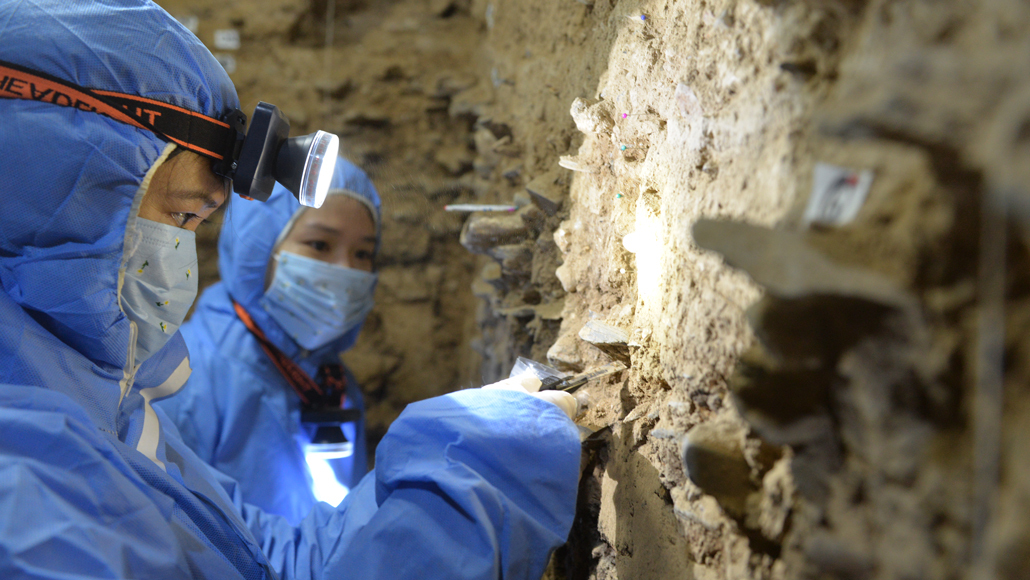Barbarian
Member
- Jun 5, 2003
- 33,356
- 2,560
Mysterious, now-extinct members of the human lineage called Denisovans lived at the roof of the world for possibly 100,000 years or more.
Denisovan mitochondrial DNA extracted from sediment layers in Baishiya Karst Cave on the Tibetan Plateau indicates that these humanlike folk inhabited the high-altitude site roughly 100,000 years ago and again around 60,000 years ago, say geoarchaeologist Dongju Zhang of Lanzhou University, China, and her colleagues. These are the first examples of Denisovan DNA found outside of Siberia’s Denisova Cave (SN: 12/16/19).
Cave sediment possibly dating from 50,000 to 30,000 years ago also yielded Denisovan mitochondrial DNA, the scientists report in the Oct. 30 Science. If further research confirms that age estimate, it raises the likelihood that Denisovans survived on the Tibetan Plateau long enough to encounter the first humans to reach those heights as early as 40,000 years ago.
In that case, ancient humans new to the region’s thin air may have acquired advantageous genetic traits for that environment by mating with resident Denisovans. Present-day Tibetans carry a Denisovan gene variant that aids high-altitude survival (SN: 7/2/14), although it’s not clear if interbreeding occurred on the Tibetan Plateau.

 www.sciencenews.org
www.sciencenews.org
Denisovans, like Neanderthals, are so closely related to anatomically modern humans that we aren't sure if they are separate species, or a subspecies with each other and with modern H. sapiens. Europeans and people from Northern Asia have a lot of Neanderthal genes, and modern humans from South Asia and Oceana have consideable Denisovan genes. So it's not a sure thing exactly when anatomically modern humans first got the allele that enables healthy life at very high altitudes.
Denisovan mitochondrial DNA extracted from sediment layers in Baishiya Karst Cave on the Tibetan Plateau indicates that these humanlike folk inhabited the high-altitude site roughly 100,000 years ago and again around 60,000 years ago, say geoarchaeologist Dongju Zhang of Lanzhou University, China, and her colleagues. These are the first examples of Denisovan DNA found outside of Siberia’s Denisova Cave (SN: 12/16/19).
Cave sediment possibly dating from 50,000 to 30,000 years ago also yielded Denisovan mitochondrial DNA, the scientists report in the Oct. 30 Science. If further research confirms that age estimate, it raises the likelihood that Denisovans survived on the Tibetan Plateau long enough to encounter the first humans to reach those heights as early as 40,000 years ago.
In that case, ancient humans new to the region’s thin air may have acquired advantageous genetic traits for that environment by mating with resident Denisovans. Present-day Tibetans carry a Denisovan gene variant that aids high-altitude survival (SN: 7/2/14), although it’s not clear if interbreeding occurred on the Tibetan Plateau.

The first Denisovan DNA outside Siberia unveils a long stint on the roof of the world
Genetic evidence puts Denisovans, humankind’s now-extinct cousins, on the Tibetan Plateau from 100,000 to at least 60,000 years ago.
Denisovans, like Neanderthals, are so closely related to anatomically modern humans that we aren't sure if they are separate species, or a subspecies with each other and with modern H. sapiens. Europeans and people from Northern Asia have a lot of Neanderthal genes, and modern humans from South Asia and Oceana have consideable Denisovan genes. So it's not a sure thing exactly when anatomically modern humans first got the allele that enables healthy life at very high altitudes.




